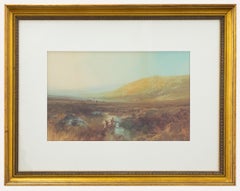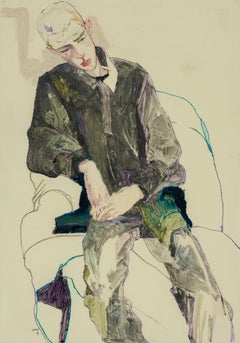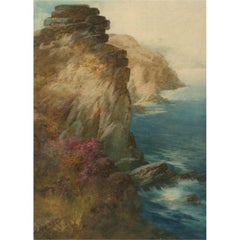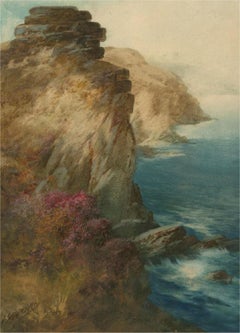John Shapland Art
to
4
3
4
1
3
Overall Height
to
Overall Width
to
1
1
1
1
1
1
1
1
1
1
3
1
4
6,857
3,171
2,516
1,217
4
3
1
Artist: John Shapland
John Shapland (1865-1929) - Framed Watercolour, Moorland Grazing
By John Shapland
Located in Corsham, GB
An original watercolour by the early 20th century landscape painter John Shapland (1865-1929). The scene depicts cattle grazing in open moorland. Signed by the artist to the lower ri...
Category
Early 20th Century John Shapland Art
Materials
Watercolor
John Shapland (1865-1929) - Watercolour, On The Coast Near St. Ives
By John Shapland
Located in Corsham, GB
This delightful watercolour study depicting the sweeping Cornish coastline near St. Ives. The artist uses gouache to highlight textural elements in the scene such as the tips of wave...
Category
Early 20th Century John Shapland Art
Materials
Watercolor
Oil Painting by John Shapland "Clovelly"
By John Shapland
Located in Mere, GB
Oil Painting by John Shapland "Clovelly" 1865 - 1929 john Shapland was principal of the Exeter school of Art and painted many loved views. Exhibited R...
Category
Early 1900s John Shapland Art
Materials
Oil
John Shapland (1865-1929) - Late 19th Century Watercolour, Mountain Range
By John Shapland
Located in Corsham, GB
A dramatic mountain landscape with sheep grazing in the foreground. Presented in a blue mount with gold detailing and a gilt-effect frame. Signed to the lower-right corner. On waterc...
Category
19th Century John Shapland Art
Materials
Watercolor
Related Items
The Abduction of the Sabine Women , a Renaissance drawing by Biagio Pupini
Located in PARIS, FR
This vigorous drawing has long been attributed to Polidoro da Caravaggio: The Abduction of the Sabine Women is one of the scenes that Polidoro depicted between 1525 and 1527 on the façade of the Milesi Palazzo in Rome. However, the proximity to another drawing inspired by this same façade, kept at the Ecole des Beaux-Arts, and to other drawings inspired by Polidoro kept at the Musée du Louvre, leads us to propose an attribution to Biagio Pupini, a Bolognese artist whose life remains barely known, despite the abundant number of drawings attributed to him.
1. Biagio Pupini, a Bolognese artist in the light of the Roman Renaissance
The early life of Biagio Pupini, an important figure of the first half of the Cinquecento in Bologna - Vasari mentions him several times - is still poorly known. Neither his date of birth (probably around 1490-1495) nor his training are known. He is said to have been a pupil of Francesco Francia (1450 - 1517) and his name appears for the first time in 1511 in a contract with the painter Bagnacavallo (c. 1484 - 1542) for the frescoes of a church in Faenza. He then collaborated with Girolamo da Carpi, at San Michele in Bosco and at the villa of Belriguardo.
He must have gone to Rome for the first time with Bagnacavallo between 1511 and 1519. There he discovered the art of Raphael, with whom he might have worked, and that of Polidoro da Caravaggio. This first visit, and those that followed, were the occasion for an intense study of ancient and modern art, as illustrated by his abundant graphic production.
Polidoro da Caravaggio had a particular influence on the technique adopted by Pupini. Executed on coloured paper, his drawings generally combine pen, brown ink and wash with abundant highlights of white gouache, as in the drawing presented here.
2. The Abduction of the Sabine Women
Our drawing is an adaptation of a fresco painted between 1525 and 1527 by Polidoro da Caravaggio on the façade of the Milesi Palace in Rome. These painted façades were very famous from the moment they were painted and inspired many artists during their stay in Rome. These frescoes are now very deteriorated and difficult to see, as the palace is in a rather narrow street.
The episode of the abduction of the Sabine women (which appears in the centre of the photo above) is a historical theme that goes back to the origins of Rome and is recounted both by Titus Livius (Ab Urbe condita I,13), by Ovid (Fasti III, 199-228) and by Plutarch (II, Romulus 14-19). After killing his twin brother Romus, Romulus populates the city of Rome by opening it up to refugees and brigands and finds himself with an excess of men. Because of their reputation, none of the inhabitants of the neighbouring cities want to give them their daughters in marriage. The Romans then decide to invite their Sabine neighbours to a great feast during which they slaughter the Sabines and kidnap their daughters.
The engraving made by Giovanni Battista Gallestruzzi (1618 - 1677) around 1656-1658 gives us a good understanding of the Polidoro fresco, allowing us to see how Biagio Pupini reworked the scene to extract this dynamic group.
With a remarkable economy of means, Biagio Pupini takes over the left-hand side of the fresco and depicts in a very dense space two main groups, each consisting of a Roman and a Sabine, completed by a group of three soldiers in the background (which seems to differ quite significantly from Polidoro's composition).
The balance of the drawing is based on a very strongly structured composition. The drawing is organised around a median vertical axis, which runs along both the elbow of the kidnapped Sabine on the left and the foot of her captor, and the two main diagonals, reinforced by four secondary diagonals. This diamond-shaped structure creates an extremely dynamic space, in which centripetal movements (the legs of the Sabine on the right, the arm of the soldier on the back at the top right) and centrifugal movements (the arm of the kidnapper on the left and the legs of the Sabine he is carrying away, the arm of the Sabine on the right) oppose each other, giving the drawing the appearance of a whirlpool around a central point of support situated slightly to the left of the navel of the kidnapper on the right.
3. Polidoro da Caravaggio, and the decorations of Roman palaces
Polidoro da Caravaggio was a paradoxical artist who entered Raphael's (1483 - 1520) workshop at a very young age, when he oversaw the Lodges in the Vatican. Most of his Roman work, which was the peak of his career, has disappeared, as he specialised in facade painting, and yet these paintings, which are eminently visible in urban spaces, have influenced generations of artists who copied them abundantly during their visits to Rome.
Polidoro Caldara was born in Caravaggio around 1495-1500 (the birthplace of Michelangelo Merisi, known as Caravaggio, who was born there in 1571), some forty kilometres east of Milan. According to Vasari, he arrived as a mason on the Vatican's construction site and joined Raphael's workshop around 1517 (at the age of eighteen according to Vasari). This integration would have allowed Polidoro to work not only on the frescoes of the Lodges, but also on some of the frescoes of the Chambers, as well as on the flat of Cardinal Bibiena in the Vatican.
After Raphael's death in 1520, Polidoro worked first with Perin del Vaga before joining forces with Maturino of Florence (1490 - 1528), whom he had also known in Raphael's workshop. Together they specialised in the painting of palace façades. They were to produce some forty façades decorated with grisaille paintings imitating antique bas-reliefs.
The Sack of Rome in 1527, during which his friend Maturino was killed, led Polidoro to flee first to Naples (where he had already stayed in 1523), then to Messina. It was while he was preparing his return to the peninsula that he was murdered by one of his assistants, Tonno Calabrese, in 1543.
In his Vite, Vasari celebrated Polidoro as the greatest façade decorator of his time, noting that "there is no flat, palace, garden or villa in Rome that does not contain a work by Polidoro". Polidoro's facade decorations, most of which have disappeared as they were displayed in the open air, constitute the most important lost chapter of Roman art of the Cinquecento. The few surviving drawings of the painter can, however, give an idea of the original appearance of his murals and show that he was an artist of remarkable and highly original genius.
4. The façade of the Milesi Palace
Giovanni Antonio Milesi, who commissioned this palace, located not far from the Tiber, north of Piazza Navona, was a native of the Bergamo area, like Polidoro, with whom he maintained close friendly ties. Executed in the last years before the Sack of Rome, around 1526-1527, the decoration of Palazzo Milesi is considered Polidoro's greatest decorative success.
An engraving by Ernesto Maccari made at the end of the nineteenth century allows us to understand the general balance of this façade, which was still well preserved at the time. The frescoes were not entirely monochrome, but alternated elements in chiaroscuro simulating marble bas-reliefs and those in ochre simulating bronze and gold vases...
Category
16th Century Old Masters John Shapland Art
Materials
Ink, Gouache, Pen
Lee Hurst (3/4 Figure, Hands Together), Mixed media on Pergamenata parchment
By Howard Tangye
Located in London, GB
Howard Tangye (b.1948, Australia) has been an influential force in fashion for decades. Lecturing at London’s Central Saint Martins for 35 years, including 16 years as head of BA Wom...
Category
2010s Contemporary John Shapland Art
Materials
Paint, Paper, Parchment Paper, Charcoal, Crayon, Oil Crayon, Oil Pastel,...
Freya (Seated Backwards), Mixed media on grey board
By Howard Tangye
Located in London, GB
Howard Tangye (b.1948, Australia) has been an influential force in fashion for decades. Lecturing at London’s Central Saint Martins for 35 years, including 16 years as head of BA Wom...
Category
2010s Contemporary John Shapland Art
Materials
Other Medium, Archival Paper, Handmade Paper, Pen, Felt Pen, Permanent M...
Gustav Melcher ( German, 1898 -?) Boats off Venice Italy Ink Water Color c. 1918
By Gustav Melcher
Located in Meinisberg, CH
Gustav Melcher
(German, 1898-?)
Segelschiffe vor Venedig - Sailing ships off Venice
• India ink, water colour wash
• Visible image ca. 11.5 x 18 cm
• Glased Frame ca. 20 x 25 cm
• Verso various inscriptions
• Signed lower right
Gustav Melcher was a German painter and a pioneer in film, film criticism and film theory and created this clever little picture of the skyline of Venice with various vessels.
Going by the various inscriptions an the backing paper, this drawing was made in 1918 when Gustav was twenty years old and passed on three years later to Gertrud Melcher on the 1. 2. 1921. I have no reasons to doubt this information. The small drawing is still in its unopened frame, so maybe there is more information to be discovered , however this will be the privilege of the next owner.
The picture also has retained its original antique frame – note that it has lost over the years various sections of the gesso decoration.
The very precisely executed drawing is most enjoyable to look at and doing so, remember you are looking through the eyes of a young man, who saw this foreign sea cape over a century ago.
Thank you for your interest and please note, that I offer free worldwide shipping on all my items.
Gustav Melcher began his studies at the Düsseldorfer Kunstakademie under Peter Janssen and Eduard von Gebhardt. Originaly he was interested in figurative and portrait painting, but after time he decided to pursue the depiction of land- and marinescapes. Durin his studies the young artist undertook trips to visit England, Scotland, Belgium and France and he joined the artist society Malkasten. It was in those days he would hold speeches to his colleges about this new invention called ‘Kintopp’ – Melcher was a great advocate of the moving pictures...
Category
1910s Naturalistic John Shapland Art
Materials
India Ink, Paper, Watercolor
Gustav MelcherGustav Melcher ( German, 1898 -?) Boats off Venice Italy Ink Water Color c. 1918, 1918
Free Shipping
H 7.88 in W 9.85 in D 0.79 in
Irises Ink, Watercolor, Oil on Yupo paper 26” x 40” Framed 31 ¼” x 45 ¼”
Located in Houston, TX
Irises by Texas artist Julie England is an Ink and Watercolor, Oil on Yupo paper. THe size of Irises is Image 26” x 40” Framed 31 ¼” x 45 ¼” Art is...
Category
2010s American Realist John Shapland Art
Materials
Mixed Media, Oil, Watercolor
"Good Health Week" WPA American Scene Mid 20th Century Modern Social Realism
By Jo Cain
Located in New York, NY
"Good Health Week" WPA American Scene Mid 20th Century Modern Social Realism
Jo Cain (1904 – 2003)
Good Health Week
10 ½ x 15 1/2 inches
Oil on pape...
Category
1940s American Realist John Shapland Art
Materials
Paper, Oil
Pavilion with waterfall, an ink wash attributed to Hubert Robert (1733 - 1808)
By Hubert Robert
Located in PARIS, FR
This large wash drawing is a slightly enlarged version of a composition executed by Hubert Robert in 1761, at the end of his stay in Rome. This composition is a marvellous synthesis of the painter's art: the clatter of the waterfall, in a grandiose setting inspired by antiquity, is opposed to the intimacy of a genre scene, made up of a few peasant women performing some agricultural work.
1. The stay in Italy, an important founding stage in Hubert Robert's carrier
Hubert Robert came from a privileged family of Lorraine origin, linked to the Choiseul-Stainville family, where his father was an intendant. The protection of this powerful aristocratic family enabled him to study classical art at the Collège de Navarre (between 1745 and 1751). After a first apprenticeship in the workshop of the sculptor Slodtz (1705 - 1764), he was invited by Etienne-François de Choiseul-Beaupré-Stainville (the future Duke of Choiseul, then Count of Stainville) to join him in Rome when the latter had just been appointed ambassador.
Hubert Robert arrived in Rome on 4 November 1754, aged twenty-one, and remained there until 24 July 1765. Thanks to his patron, he obtained a place as a pensioneer at the Académie de France without having won the prestigious Prix de Rome. On his arrival in Rome, he frequented the studio of the painter Giovanni Paolo Panini (1691 - 1765), the inventor of the ruins painting, and also benefited from the proximity of Giovanni Battista Piranesi’s studio (1720 - 1778). During his eleven-year stay in Rome, Hubert Robert studied the great Italian masters and drew many of the great archaeological sites, multiplying the sketches which he would use throughout his career, becoming one of the masters of the "ruin landscape".
Back in Paris in 1765, he was very successful. He was accepted and admitted to the Royal Academy of Painting and Sculpture on the same day, July 26th 1766, which was very unusual. He was appointed draughtsman of the king's gardens in 1784, then guard of the Royal Museum from 1784 to 1792. Arrested in 1793 and detained in the prisons of Sainte Pélagie and Saint-Lazare, he was released in 1794 after the fall of Robespierre and undertook a second trip to Italy. In 1800, Hubert Robert was appointed curator of the new Central Museum and died at his home in Paris in 1808.
2. Description of the artwork
This composition, formerly called "La Cascade du Belvédère Pamphile" , is undoubtedly inspired by the water theatres of the Frascati villas. Hubert Robert presents a hemicycle of columns with rustic bossages at the foot of which is a cascade of water falls into a basin. The hemicycle is flanked by two high walls, pierced by window wells topped with antique masks...
Category
1760s Old Masters John Shapland Art
Materials
Ink, Watercolor
Bridge to Brooklyn #382
Located in Salt Lake City, UT
Bridge to Brooklyn #382, watercolor, 10.5 x 14 inches (Framed size: 18 x 21 inches), $1,750
Waldo Midgley (1888-1986) had a fruitful career spanning eig...
Category
1970s Ashcan School John Shapland Art
Materials
Watercolor
Hay stacks. 1981. Oil on cardboard, 22x30 cm
By Edgars Vinters
Located in Riga, LV
Hay stacks. 1981. Oil on cardboard, 22x30 cm
Category
1980s Impressionist John Shapland Art
Materials
Cardboard, Oil
'Fall Fog Approaching'. Contemporary Landscape Clouds Moody sky Blue Green Brown
By Sophia Milligan
Located in Penzance, GB
'Fall Fog, Approaching'. Contemporary landscape painting, Cornwall
Original Artwork, Unframed
_________________
Heavy skies moving in over the autumnal landscape of West Cornwall: a ...
Category
2010s Contemporary John Shapland Art
Materials
Ink, Watercolor, Archival Paper
Free Shipping
H 12 in W 12 in
Cowboys Horses Cattle WPA American Scene Social Realism Mid 20th Century Modern
By Jo Cain
Located in New York, NY
Cowboys Horses Cattle WPA American Scene Social Realism Mid 20th Century Modern
Jo Cain (1904 – 2003)
Cowboy
33 3/4 x 36 inches
Oil on paper, c. 1930s
Signed...
Category
1930s American Realist John Shapland Art
Materials
Paper, Oil
'Amalfi, Italy', mixed media on paper c2005
Located in Frome, Somerset
'Amalfi, Italy'. Mixed media on paper . circa 2005.
painting 41cm x 54cm
glazed frame 62cmx 82cm
Atmospheric view of the seafront topography and buildings of the famous coastal town...
Category
Early 2000s Modern John Shapland Art
Materials
Watercolor
Previously Available Items
John Shapland (1865-1929) - 19th Century Watercolour, Castle Rock Lynton
By John Shapland
Located in Corsham, GB
This charming scene depicts the stunning cliffs of Castle Rock in Lynton. Summer wildflowers are shown along the cliff's edge before the crashing waves below. Signed to the lower lef...
Category
19th Century John Shapland Art
Materials
Watercolor
John Shapland (1865-1929) - 19th Century Watercolour, Castle Rock Lynton
By John Shapland
Located in Corsham, GB
This charming scene depicts the stunning cliffs of Castle Rock in Lynton. Summer wildflowers are shown along the cliff's edge before the crashing waves below. Signed to the lower lef...
Category
19th Century John Shapland Art
Materials
Watercolor
John Shapland (1865-1929) - Signed Gouache, Cornish Coastal Landscape
By John Shapland
Located in Corsham, GB
A late 19th Century coastal landscape depicting a beach with cliffs in the distance, possibly of the Cornish Coast due to the artist living in the area. Well presented in a gilt fram...
Category
19th Century John Shapland Art
Materials
Gouache
John Shapland art for sale on 1stDibs.
Find a wide variety of authentic John Shapland art available for sale on 1stDibs. You can also browse by medium to find art by John Shapland in paint, watercolor, oil paint and more. Not every interior allows for large John Shapland art, so small editions measuring 22 inches across are available. Customers who are interested in this artist might also find the work of Vito Alghisi, Elaine Kaufman Feiner, and Laurence H.F. Irving. John Shapland art prices can differ depending upon medium, time period and other attributes. On 1stDibs, the price for these items starts at $350 and tops out at $1,625, while the average work can sell for $463.
Artists Similar to John Shapland
Robert Sargent Austin, R.A., P.R.E., P.R.W.S.






